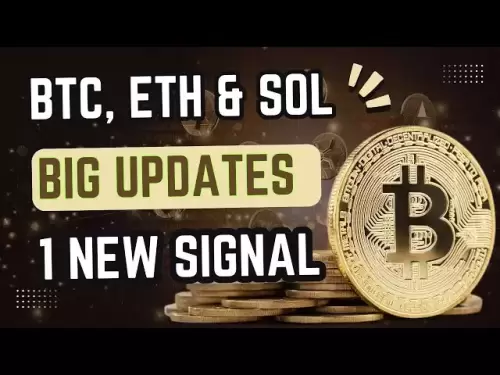 |
|
 |
|
 |
|
 |
|
 |
|
 |
|
 |
|
 |
|
 |
|
 |
|
 |
|
 |
|
 |
|
 |
|
 |
|
フィラデルフィア連邦準備制度のMAY製造業の見通し調査における前例のない急増により、世界的なリスク市場が揺れています

The massive surge in the Philadelphia Federal Reserve’s May Manufacturing Business Outlook Survey has jolted global risk markets and given crypto asset traders their clearest macro catalyst of the year.
フィラデルフィア連邦準備制度のMAY製造業ビジネス展望調査の大規模な急増により、グローバルなリスク市場が揺れ、Crypto Asset Tradersが今年最も明確なマクロ触媒を与えました。
What Happened: The massive reading on Monday saw the Future New Orders diffusion index rise by forty-plus points, a move that Julien Bittel, head of macro research at Global Macro Investor (GMI), called “literally” historic.
何が起こったのか:月曜日の大規模な読書では、将来の新しい注文拡散指数が40以上のポイント増加を見ました。これは、「文字通り」歴史的と呼ばれるグローバルマクロ投資家(GMI)のマクロ研究責任者であるジュリアン・ビッテルが動きました。
“Philly Fed data for May dropped yesterday — and the Future New Orders index just made history. Literally. ... Expectations for new orders posted the largest monthly spike ever recorded — going all the way back to the index’s inception in May 1968. A staggering +4.3 standard deviation move,” Bittel said in a post on X.
「Philly Fed Fedデータは昨日削除されました - そして、将来の新注文指数は歴史を作りました。...新しい注文への期待は、これまでに記録された最大の毎月のスパイクを投稿しました。1968年5月にインデックスの開始にまでさかのぼります。
For perspective: that’s an even bigger move up than the downside collapse during the depths of the 2008 Global Financial Crisis (-4.1σ). Let that sink in.
視点の場合:それは、2008年の世界的な金融危機(-4.1σ)の深さ中のマイナス面崩壊よりもさらに大きな動きです。それを沈めましょう。
Philly Fed data for May dropped yesterday — and the Future New Orders index just made history. Literally.
Philly Fed Data for Mayは昨日削除されました。そして、将来の新しい注文指数はちょうど歴史を作りました。文字通り。
Expectations for new orders posted the largest monthly spike ever recorded — going all the way back to the index’s inception in May 1968. A staggering +4.3 standard deviation move.
新しい注文の期待は、これまでに記録された最大の月間スパイクを投稿しました。1968年5月のインデックスの開始にまでさかのぼります。
— Julien Bittel (@globalmacrobias) May 16, 2024
-Julien Bittel(@globalmacrobias)2024年5月16日
Q1 growth was weak. The reason is straightforward — financial conditions tightened sharply in Q4. The dollar ripped, bond yields surged … a classic tightening phase. This set up a perfect storm for slower activity.
Q1の成長は弱かった。その理由は簡単です - 第4四半期には金融条件が急激に強化されました。ドルが引き裂かれ、債券の収益が急増しました...古典的な引き締め段階。これにより、より遅いアクティビティのための完璧な嵐が設定されました。
Proximate trigger: businesses panic-loading inventories ahead of Trump tariffs, and markets front-running the inflation narrative. These dynamics are a direct replay of Q4 2016 during Trump’s first term. Just like early 2017, that tightening spilled over into slower growth momentum in Q1. We’ve highlighted repeatedly: this had all the hallmarks of Q4 2016 during Trump’s first term.
近似トリガー:企業は、トランプの関税に先立って在庫をパニックに陥れ、市場はインフレの物語を最終的に走ります。これらのダイナミクスは、トランプの最初の任期中の2016年第4四半期の直接のリプレイです。 2017年初頭と同じように、その締め付けは第1四半期のより遅い成長の勢いにこぼれました。私たちは繰り返し強調しました。これは、トランプの最初の任期中に2016年第4四半期のすべての特徴を持っていました。
Where 2017 began with doubt and ended in a synchronous global boom, 2024 is rhyming. Those Q1 headwinds have flipped into Q2 tailwinds. Everything flows downstream from changes in financial conditions …
2017年は疑いから始まり、同期グローバルブームで終了した場合、2024年は韻を踏んでいます。これらのQ1の逆風は、第2四半期の尾翼にひっくり返りました。すべてが財政状態の変化から下流に流れます…
Purchasing managers’ expectations are shifting — and shifts in thinking eventually translate into action. Sentiment shifts first. Action follows. It always does. Bullish.
マネージャーの期待は変化しています。そして、思考の変化は最終的に行動につながります。センチメントは最初にシフトします。アクションが続きます。それは常にそうです。強気。
Crypto traders responded accordingly, with Bitcoin reclaiming the $104,000 level in early-European trade, though it later slipped. Ether remained steady near the $2,600 mark, and high-beta layer-one tokens such as Solana and Avalanche also moved in tandem.
Crypto Tradersはそれに応じて対応し、ビットコインはヨーロッパの初期貿易で104,000ドルのレベルを取り戻しましたが、後に滑りました。エーテルは2,600ドルのマークの近くで安定したままであり、ソラナや雪崩などのハイベタ層1トークンもタンデムに移動しました。
An upside economic shock like this — +4.3σ on new orders — is rare. But the bigger story is market positioning. Asset prices are not prepared. The melt-up is the asymmetric risk. Now it’s being repriced.
このような上向きの経済的ショック - 新しい注文の +4.3σ - はまれです。しかし、より大きな話は市場のポジショニングです。資産価格は準備されていません。溶融は非対称のリスクです。今では再リケートされています。
Indeed, the scale of the shock is less important than how under-positioned investors are for an upside growth surprise. This is a buffer against further downside in the new year.
確かに、ショックの規模は、過小ポジションの投資家が逆さまの成長の驚きのためにどれほど重要ではありません。これは、新年のさらなるダウンサイドに対するバッファーです。
When this dropped, markets didn’t even blink. Because the shift’s already in motion. This wasn’t news, it was confirmation. That’s the real tell, when markets shrug off a four-sigma upside shock. It means the turn is already upon us — and it’s just getting started.
これが落ちたとき、市場は瞬きすることさえしませんでした。シフトがすでに動いているからです。これはニュースではなく、確認でした。それは、市場が4シグマの逆さまのショックをめちゃくちゃにしたときの本当の話です。それはすでにターンが私たちの上にあることを意味します - そして、それはちょうど始まっています。
The Philly Fed's Manufacturing Business Outlook Survey for May 2024 showed a massive shift in expectations for new orders. The diffusion index rose by a staggering 40-plus points to 38.0, marking the largest monthly spike in the index's history, which spans back to May 1968.
2024年5月のフィラデルフィアFRBの製造業の見通し調査では、新規注文に対する期待の大幅な変化が示されました。拡散インデックスは、40以上の驚異的なポイントで上昇し、38.0で上昇し、1968年5月に及ぶインデックスの歴史の中で最大の毎月のスパイクをマークしました。
This surge was so significant that it surpassed even the depths of the 2008 Global Financial Crisis, where the index saw a -4.1 standard deviation move in the third quarter.
この急増は非常に重要であったため、2008年のグローバルな金融危機の深さでさえも上がり、インデックスでは第3四半期に-4.1標準偏差が動きました。
The survey's results also indicated a substantial increase in the employment diffusion index, which jumped from -12.0 to 10.0, the highest reading since April 2022.
調査の結果は、2022年4月以降の最高の読書である-12.0から10.0に跳ね上がる雇用拡散指数の大幅な増加を示しています。
This optimistic economic snapshot stands in stark contrast to the pessimistic outlooks from both the New York Federal Reserve's Consumer Expectations Survey and the University of Michigan's final consumer sentiment index for May.
この楽観的な経済的スナップショットは、ニューヨーク連邦準備制度の消費者期待調査とミシガン大学の5月の最終消費者感情指数の両方からの悲観的な見通しとはまったく対照的です。
These surveys highlighted consumers' dampened expectations for both inflation and income gains over the coming year.
これらの調査では、来年のインフレと収入の両方の利益に対する消費者の期待が減衰したことを強調しました。
The crypto market responded accordingly, with Bitcoin reclaiming the $104,000 level in early-European trade, though it later slipped. Ether remained steady near the $2,600 mark, and high-beta layer-one tokens such as Solana and Avalanche also moved in tandem.
暗号市場はそれに応じて対応し、ビットコインはヨーロッパの初期貿易で104,000ドルのレベルを取り戻しましたが、後に滑りました。エーテルは2,600ドルのマークの近くで安定したままであり、ソラナや雪崩などのハイベタ層1トークンもタンデムに移動しました。
At press time, the total crypto market cap stood at $3.28 trillion.
プレス時に、総暗号時価総額は3.28兆ドルでした。
免責事項:info@kdj.com
提供される情報は取引に関するアドバイスではありません。 kdj.com は、この記事で提供される情報に基づいて行われた投資に対して一切の責任を負いません。暗号通貨は変動性が高いため、十分な調査を行った上で慎重に投資することを強くお勧めします。
このウェブサイトで使用されているコンテンツが著作権を侵害していると思われる場合は、直ちに当社 (info@kdj.com) までご連絡ください。速やかに削除させていただきます。




























































![高脂質[誇大広告]価格は24時間で9.5%急増します 高脂質[誇大広告]価格は24時間で9.5%急増します](/uploads/2025/05/17/cryptocurrencies-news/articles/hyperliquid-hype-prices-surge-hours/682867d4965f9_image_500_300.webp)
